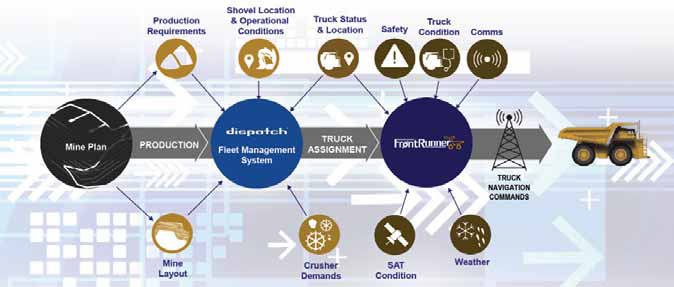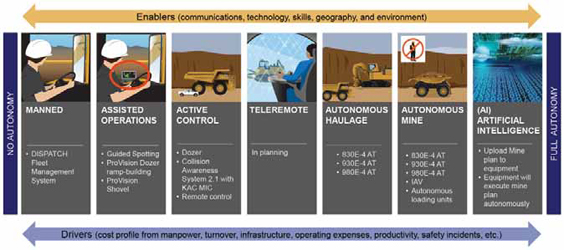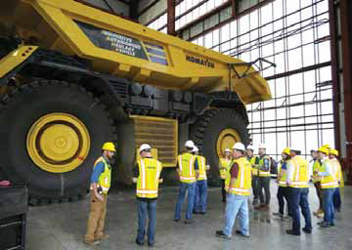
Komatsu tests autonomous haulage at its 700-acre proving grounds outside Tucson, Arizona.
Komatsu Debuts Advanced
Autonomous Systems
A market leader offers autonomous mining insight during a demo at its proving
grounds in Tucson, Arizona
By Steve Fiscor, Editor

The ideal mine plan for autonomous operations has less intersections than traditional open-pit operations. The dump and loading areas will likely be a little larger. Haul road design and maintenance will be even more important, especially if the autonomous fleet is interacting with manned vehicles.
During October, Komatsu Mining held a demo at its proving grounds in Tucson, Arizona, offering access to a select group of trade press writers and customers. Autonomous mining experts provided information on where the industry stands today, fielded questions and offered insights about the future of this technology.
While autonomous mining is not the best option for every mine, there are different degrees along the autonomy spectrum from manned to full autonomy supported by artificial intelligence (AI). Many operations already take advantage of fleet management systems (FMS) and guidance from global positioning systems (GPS). They also have collision avoidance systems. Some operations, for example, are considering operator assist around the loading and dump points. Advanced central control platforms integrate all these applications. Someday, artificial intelligence will improve operations continuously.
Komatsu pioneered the AHS when it started down this path 30 years ago. The primary objective was to move as much rock as safely and cost effectively as possible. Today, the company has autonomous fleets operating in Canadian oil sands, Chilean copper and Australian iron ore. They have also tested it in coal applications and believe the technology is transferable. With 130 autonomous trucks operating worldwide, Komatsu and Modular Mining Systems have a great deal of experience and they are looking to advance to the next level.
The Autonomous Timeline
Komatsu Mining is a subsidiary of a major
Japanese equipment manufacturer. The
haul trucks are researched, designed and
built in Peoria, Illinois. The autonomous
technology was developed in Japan. Modular
Mining is a subsidiary of Komatsu
and its Dispatch FMS is an integral part
of the autonomous truck, optimizing the
haulage cycle.
In mining, autonomous means a controlled presence, explained Brian Yureskes, director of global account management for Komatsu. “It’s all about reducing variability and making everything work as it should,” he said. “A couple of advantages that customers report are the increases in productivity and a reduction in their total cost of ownership. One of the biggest benefits is the truck itself. It’s very reliable and it runs consistently.”
Anthony Cook, vice president autonomous and continuous solutions for Modular, pointed to the safety factor, explaining that these systems reduce the number of operators and their exposure to the mining environment. “When mines connect to autonomous, they are putting all of their trust in [us],” Cook said. “The biggest thing we have is the experience and we can bring that to the mine sites and make them successful.”
Komatsu recently achieved a milestone of 2 billion metric tons (mt) moved with autonomous trucks. “However, what we are most proud of is the safety results,” Yureskes said. “Zero autonomous hauler-related incidents in 10 years of operations.”
While the first autonomous testing started in Japan in 1990, the process technically began with the release of the Dispatch FMS in the late 1980s. It became the foundation for Komatsu’s autonomous platform and it’s the reason the two companies formed the original partnership. “We have been working on this for a long time,” Cook said.

“Using those two deployments, we began to learn more about the systems,” Yureskes said. “That’s when more specific application development began, which led to the first North American deployment with Suncor Energy in 2016.”
Similar to traditional open-pit mines, the foundation of a strong autonomous platform is the mine plan. The inputs and the production requirements are the basis for the system design. One of the biggest advantages for Komatsu is the Dispatch FMS and integrating it with its FrontRunner system to issue assignments to the trucks through a central control unit.
“One of the misconceptions about autonomous mining is that it’s a relatively simple bolt-on remote-control system,” Yureskes said. “That’s not the case. The true benefit of the system is the integration of all these systems together.”
Different Levels of Autonomy
When Yureskes talked about autonomy,
he explained that there is a spectrum
of technologies that range from manned
operations to complete artificial intelligence.
“Right now, we fall right in the
middle of this spectrum as far as trucks
operating without drivers,” Yureskes said.
“Not only do we offer multiple solutions
for autonomous technologies, some of
those will be integrated into mine sites
based on the needs of that mine site — a
customized solution.”
The Komatsu AHS has five components: the autonomous haul trucks, the loading equipment, equipped manned vehicles, FrontRunner central control, and the wireless communications network. Acting as the brains of the operation, Front- Runner issues assignments and acts as a supervisory system for the entire operation.
The benefits of this system are improved safety, precision and repeatability, and efficiency. All of which will drive productivity increases and help keep costs low. “The precision, as in where the materials are placed, limits re-handle and improves haulage cycle times,” Yureskes said. “The performance is repeatable and predictable, which keeps mine planning and budgeting consistent and improves the overall efficiency at the mine site.”
He also cited several possible ancillary benefits depending on the operation, such as lower fuel consumption, increased tire life and reduced maintenance costs. These result from the truck running within the design envelope with no human variability as far as how the truck is operated.

Implementing the System
The FrontRunner system has a basic set
of requirements. The autonomous equipment
needs to be segregated from the
manned equipment with proper signage
and barricades. Personnel need to be
properly trained to understand the system
and how to get the most out of it. A central
operator must monitor all the equipment
and communicate with everyone. A Pit Patroller
roves around the mining area monitoring
the conditions, including the haul
roads and the load and dump zones. The
system needs to be secure with consistent
access to GPS and reliable communications.
Safety protocols must be followed.
Autonomous mining will not magically make a poorly designed mine more efficient. “When you automate junk, you get automatic junk,” Yureskes said. “There are specific mine design qualities that Komatsu would like to see, such as simple fixed courses. More than point A to point B, the system needs clearly defined destinations and instructions — one where the system requires less interaction with central control. That way the trucks can operate more effectively.”
Intersection planning becomes vital. T intersections and areas where the autonomous haul trucks interact regularly with other manned vehicles creates a hassle. Designing those situations out of the mine plan allows the system to run more effectively. “Ideally, we want to see wide roads and larger dumping and loading areas,” Yureskes said. “Well-maintained haul roads are key and we want to minimize manned vehicle interactions, such as bulldozer, graders, pickups, etc.”
Successful implementation depends on acceptance and the knowledge of the personnel operating the system. The Pit Patroller needs to consistently communicate with Central Control. The loading equipment operators create spot courses for the autonomous trucks and maintain the loading area. The operators on the support equipment must also understand the system and the importance of removing obstacles. The Central Controller monitors the system, handles the exceptions and coordinates with Dispatch.
Komatsu has a robust training program for technicians and overall equipment operations. “It starts with establishing a foundation through eLearning and virtual classroom,” Yureskes said. “The object is to get people up to speed as quickly as possible and deploy the training to as many people as we can at one time. We can do that on site or at the proving grounds. We also offer simulator training. A lot of this training takes place well before these personnel are in the field interacting with the autonomous system.”
Once they are in the field, Komatsu starts the hands-on validation training. “They have to demonstrate a certain level of skills before they can graduate to the next level,” Yureskes said. “It’s competency- based training that’s certificated. This is included in the site licenses that’s issued to the mine. The foundation and process of training would be very familiar, but the autonomous aspect would be something new.”
Yureskes reminded people that the system is not a one-size-fits-all solution. “With these installations, there is a lot of customization,” he said. “Komatsu will have dedicated on-site support. The operations that get the most of out the system are the ones where the lines between the customer and Komatsu are blurred and they are working together in a partnership with mutual goals.”
The Technology Guiding the System
The Komatsu AHS system relies on two
applications: FrontRunner, which is controlling
the truck; and Dispatch, the same
Modular FMS that’s already being used
at many mines today. “Dispatch doesn’t
care if the truck is manned or not,” Cook
said. “It’s treating it as an asset and it’s
trying to determine how to get the most
tons out of the system.”
In the Central Control Room at the Komatsu proving grounds, Cook explained how Modular tests new hardware and software before its released to the customer. “About 90% of the test work is conducted at Modular Mining’s headquarters in Tucson before they bring it to the proving grounds,” Cook said.
The Komatsu proving grounds opened in late 2015 and the company uses the 700- acre facility to test open-pit mining equipment. There are three models of autonomous haul trucks operating at the facility, an 830, 930 and a 980. The loading units vary from a rope shovel to hydraulic front shovels all the way down to wheel loaders.

The manned vehicles have a device telling them the position and route of the trucks and where they will turn. “We no longer need indicators because the operators stop when they see a truck and look at their screen to see where that truck is going,” Cook said.
The backbone to all of this is the wireless communication. Most mines today use WiFi, the 80211 band, but Cook foresees a mass migration to long-term evolution (LTE) wireless. “With video and all the data coming out of the pits, LTE will be a better application,” Cook said. “It’s more mobile jumping from access point to access point. Wi-Fi was designed as a stationary system, which works well for offices and factories.”
None of the technology on the truck is proprietary. “Anyone could buy these parts and cobble them together,” Cook said. “What is proprietary is how the different levels of information are integrated into the system and the IP for the system. A PTX-C mobile computer accepts the messages from Centrol Control and disseminates them through the truck’s control systems to make it propel, brake, and turn left or right.”
The trucks use multiple methods — GPS, a set of gyros as well as radar and lasers — to verify its position. Currently, the system connects to two constellations, but the next generation will connect to four. The autonomous truck operates with such repeatable precision that the engineers are now incorporating “vectoring,” where an algorithm shifts the haulage route laterally a meter or so to keep the trucks from wearing ruts in the haul road.
FrontRunner also expects to hear regularly from certain sensors on board the truck. “These sensors, such as the steering sensors, act as a heartbeat,” Cook said. “The system is looking for data at least once a second. The truck will slow down if the system is not getting confirmation signals from those sensors.”
During system development, Modular performs a stability test. “Once we have a software candidate for release, we will conduct thousands of tests, troubleshooting everything, not just the custom changes we made for this particular system,” Cook said. “If an unexplained event occurs in the field after the system is installed, we try to replicate it here and troubleshoot it.”
FrontRunner looks for the commands from Dispatch. The truck gets its assignment as far as dig or dump location. It gets kicked out from the shovel and goes to the assigned dump point, dumps and then waits for the return assignment. “We work with dynamic assignments,” Cook said. “If something happens in the cycle where the digging goes down, Dispatch reassigns the trucks automatically.”
Whether it’s loaded or empty, each truck projects a path based on its momentum. “The trucks are using those paths as permission,” Cook said. “They are buying real estate ahead of them and releasing it behind them. Two trucks can’t own the same piece of real estate. Each vehicle has a safety bubble that protects the driver. Manned vehicle interactions, passing and travel modes, cause the trucks to stop or at least change its characteristics, such as slowing it down.”
Komatsu recently organized a thirdparty hack to find vulnerabilities. “Wi-Fi is the weak point,” Cook said. “To protect against that, we have a number of firewalls. Most mines operate in rather remote locations and the hackers would have to be physically present near the site. It’s not so easy to get to the Pilbara or the Canadian oil sands. What we determined is that, if there were a problem, it would most likely be an internal issue.”
The biggest fear, Cook explained, would be ransom software. “If they took control of the system, they could try to extort money,” Cook said. “But, the system is backed up, so we could shut it down and reload it.”
When it comes to double-sided loading, a lot of manned-operations claim they are using it, but the results are not nearly as repeatable as autonomous operations. In the future, manned operations could take advantage of guided spotting, a technique that guides operators to the optimum loading location. “We are past proof of concept on this technology and it’s truck agnostic,” Cook said. “The second phase will feed information into a machine controller, which would allow a manned truck to be backed into position autonomously.”
“With autonomous mining, the mines face a choice,” Cook said. “They can produce more tons with the same spread. Or, they can park equipment and produce the same amount. Everything is site specific, but a typical operation that would be using 18 trucks might be able to do the same thing with 15 trucks. That varies with haul and ramp distances.”
Mixed Fleets vs. Interoperability
The Komatsu AHS can coexist with
manned vehicles (mixed fleets) and other
makes and models (interoperability).
“There are usually some issues with
mixed fleets around the dump zone,”
Cook said. “When the manned truck
makes a mistake, the autonomous truck
will view that as an obstacle. Most of the
dumps are large and they can be easily
divided into manned and autonomous operations.
But, certainly around the crusher
and on the haul roads, we can operate
manned and autonomous trucks at the
same time.”
As far as interoperability, Cook said that, when it comes to AHS, Modular is squarely focused on Komatsu trucks. “Our position on retrofitting other manufacturer’s trucks? It’s too much of a risk. Look at the airlines, they both operate with GPS, radar and lasers, but Boeing won’t retrofit its guidance system on the Airbus.”
“There are companies that are retrofitting systems to several makes and models, but that’s not true interoperability,” Cook said. “True interoperability is being able to pass through industry protocols, which agree on how information is sent from central control to agnostic vehicles. Safety is a big concern here.”

Several standards are being reviewed and Komatsu and Modular are part of that discussion.
What Happened to That IAHV?
The Innovative Autonomous Haulage Vehicle (IAHV) stole
the show at MINExpo 2016 and many E&MJ readers are probably
wondering what happened with that machine. After the
event, Komatsu shipped it from Las Vegas to its proving grounds
in Tucson.
Similar to the 830ACX, the IAHV has a 250-ton payload. It’s powered by a 2,700-hp engine. Aside from being cab-less, one of the big differences is that it only has four tires compared to six on a traditional hauler. Another big difference is that the air filters and radiators are positioned on the side of the machine with easy access. It was designed as unidirectional, meaning no front or back end, although it can only dump one way. The idea was to reduce the spotting times.
The IAHV was a concept machine and it had not been tested prior to its debut at MINExpo 2016. During the last two years, it has been enduring a battery of machine testing, autonomous system testing and collision avoidance testing, both independently and as a system.